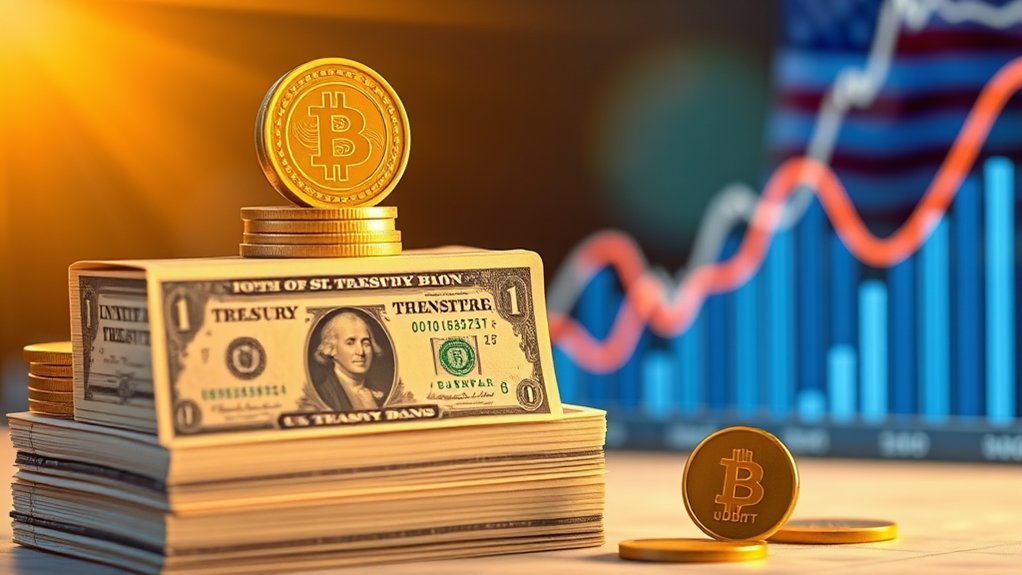Will stablecoins fuel US demand? Yeah, stablecoins, those “stable” crypto things, are buying *tons* of US Treasury bonds. I mean, billions. They need reserves, apparently. This is shaking up the bond market, maybe even helping the Treasury. But, seriously, what happens if these stablecoins tank? A giant Treasury fire sale? Regulators are definitely watching because, well, crypto. There’s more to unpack.

Stablecoins, those digital tokens pegged to stable assets like the US dollar, are doing more than just facilitating crypto trades; they’re quietly gobbling up US Treasury bonds. It’s pretty wild when you think about it. These crypto things, supposedly some future of finance, are relying on old-school government debt.
Stablecoins need reserves, right? To back their value, so they don’t just become worthless pixels. And a huge chunk of those reserves? US Treasuries. Yup. Short-term bills, mostly. The really safe stuff. They address extreme price volatility seen in other cryptocurrencies.
The scale of this is getting big. We’re talking billions. Issuers like Tether and Circle, the big players, are parking serious cash in government debt. This isn’t just couch change. They’ve become significant holders. It’s like a new, unexpected buyer showed up at the Treasury auction. The most widely used stablecoin is Tether (USDT), and it is backed by USD reserves.
The market’s taking notice. Less supply of those specific bonds because stablecoins are holding them. Could push prices up, yields down for those parts of the curve. Economics 101, basically.
Regulators are looking at this, obviously. Can’t have something this big happening in crypto without Uncle Sam peeking around. They want to know if these reserves are truly safe. What happens if there’s a run on a stablecoin? Do they dump all those Treasuries at once? That could cause some market jitters, for sure. Transparency issues contribute to concerns about stablecoin reliability; historically, a lack of clarity has led to market instability. It’s a valid question.
On the flip side, the Treasury department probably isn’t complaining too much. More buyers mean more demand for their debt. Makes it a little easier to finance the government’s spending habits. Unlike traditional cryptocurrencies, these fiat-collateralized stablecoins maintain steady value by holding reserves in traditional currencies. It’s a win-win, for now, maybe?
But there are risks. What if the stablecoin industry implodes? Not saying it will, but you gotta consider it. A fire sale of billions in Treasuries? Not ideal.
Also, what if regulations change dramatically? Could force stablecoin issuers to hold different assets. Uncertainty, like always in crypto.
Frequently Asked Questions
Will Stablecoins Fuel US and Cause Hyperinflation?
The question of whether stablecoins will cause hyperinflation is complex.
Their design often aims for price stability by being pegged to existing currencies or assets. The risk of uncontrolled money printing, a driver of hyperinflation, is intended to be mitigated through diverse reserve mechanisms.
However, concerns exist regarding transparency and the potential for collateral issues if not properly managed, which could potentially lead to instability.
Are Stablecoins Regulated Like Banks?
Current regulation of stablecoins is a complex and changing issue.
Are stablecoins regulated like banks? Not exactly the same.
Legislative efforts are underway, aiming for oversight. Some proposals push for bank-like requirements. Others suggest customized structures.
It’s a work in progress, frankly. The feds are still figuring it out. Big money talk fuels the debate.
Who Profits From Stablecoin Bond Purchases?
Stablecoin issuers pocket yield.
US Treasury scores buyers, maybe cheaper debt.
Custodians earn fees.
Money market funds get inflows.
Bond brokers make trades.
Stablecoin holders feel safe, supposedly.
Everyone gets a piece.
What Are Stablecoins Backing US Bonds?
Certain digital currencies, stablecoins, maintain value peg via reserve assets.
Often, these reserves include US government debt. Treasury bills, short-term bonds.
Big stablecoin issuers hold a chunk. Means stablecoins are buying US bonds, enhancing demand.
That’s the deal.
Can Stablecoins Replace the Dollar?
Can stablecoins *really* replace the dollar? That’s a big ask.
Stablecoins, like USDT and USDC, are pegged to the dollar, right? So they’re kinda parasites, feeding off the dollar’s stability.
Regulators are watching, getting twitchy about reserves and stuff. The dollar’s got history, global trust.
Stablecoins? Still the new kids, trying to prove they’re not gonna implode. Big difference.
